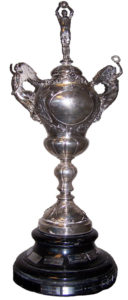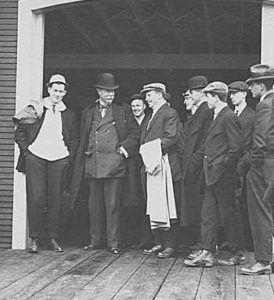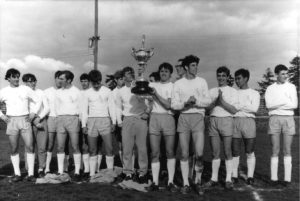
At the ripe old age of 90, Mr. Lipton stands up straight, and though he shows signs of obvious wear there is a gleam to his appearance. Women with flowing hair, goddesses perhaps, flank him on either side.
Lipton’s got it pretty good. Folks take care of him, and he’s got a room with a view. Unlike his prime, he no longer gets out much, if at all, and the notion of young people picking him up and jubilantly hoisting him skyward is certainly out of the question. Still, with proper care and attention, there’s no reason to think Lipton won’t outlive us all.

Such is life for the stately Sir Thomas Lipton Trophy, likely among the oldest surviving artifacts of a rich soccer history that reaches back to the days before Washington’s statehood. Lipton and other sterling relics of their kind are hiding around the Seattle area, some of them in plain sight.
While the brightly-lighted Sounders FC trophy case on Occidental displays our biggest, brightest and most recent plunder–a Major League Soccer Supporters’ Shield plus four U.S. Open Cups–the bulk of Washington’s historical treasures reside in a couple ordinary offices.
Lipton lives near the banks of the Green River, at Washington Youth Soccer headquarters in Tukwila. The rooms next door is the domicile of the masculine Hamilton Douglas Cup and, for dessert, the decadent Wickman Pie Cup.
Up in north Seattle are the stately George Washington Trophy and the authentically funky Chidgey Memorial Trophy. Elsewhere are more modern treasures: the NASL Sounders’ division championship trophies and Trans-Atlantic Challenge Cup.
Silver means business
In researching our collective history in the world’s game, there is mention of informal play in the 1880s. Yet when silver is introduced, one gets the clear sense that the football’s become far more serious than holiday challenge matches and mining camp kick-arounds. Railway bosses, timber barons and Klondike gold diggers kindly contributed some sparkling cups and it was game on.
However no trophy is as storied as the Lipton. One-hundred years ago, seeking to add luster to the local juniors championship, association secretary Jock Simpson wrote a letter to international sportsman and Irish tea magnate Sir Thomas Lipton. It was later likened by scribes to asking John D. Rockefeller to sponsor a bowling team 5,000 miles away. It literally was a longshot.
But to Simpson and everyone’s surprise, Lipton not only replied, first with a letter, then with a crate. The latter’s contents: a London jeweler-designed trophy of sterling silver standing nearly 3 feet high. It’s original value: $1,000 (over $13,000 today).
It’s quite possible, however, that Simpson was quite calculating in his request. Fourteen years earlier Lipton, following a pleasurable two-week stay on the Puget Sound, bequeathed an even more ornate, three-tiered piece to the Seattle Yacht Club. It’s price: $3000 ($39,000 today).
“That trophy is worth a lot of money,” affirms Monty Holmes, whose family has operated Athletic Awards since 1949 in South Lake Union. “It’s solid sterling silver and (to replace it) would cost close to $100,000.”

While the sterling itself may be worth only half that, depending on market prices, there simply are not many working silversmiths these days. “That stuff is just not made anymore,” states Holmes.
For more than 50 years the Lipton soccer trophy was contested, lifted and passed along, each boys U17 winning side seeing its name engraved on the black base.
Off the shelf
The McMillan Cup was commissioned by lumberman John C. McMillan in 1912. According to historian J Michael Kenyon, it was awarded to winners of at least a half-dozen different leagues and competitions. Explains Kenyon: “There were about seven or eight long-lasting trophies, but nearly all of them were like doctors-on-call. Whenever a trophy was needed, someone seemingly would reach up on the shelf and whatever they brought down was used for that purpose.”
For over 40 years the McMillan Cup was taken outside and held aloft. In many cases it was filled with champagne for victorious players to imbibe. Its whereabouts now are unknown. Perhaps it was one of the four trophies lost in a 1975 soccer shop fire. Then again, maybe its holding court on someone’s mantle or hidden in an attic. It wouldn’t surprise Holmes if the McMillan or a peer piece surfaced someday.
“I can tell you stories of trophies from the University of Washington or other longtime organizations where the trophy shows up in someone’s closet,” he shares. “Someone or some team won the award, took it home and now keeps it on display in house.”
As for those other pieces that are relatively out in the open, here’s some notes:
NASL Soccer Bowl Finalist trophy: Although not worth but than $300, it represents the Sounders’ near-miss upset of the Cosmos in Soccer Bowl ’82. An identical trophy was earned for the 1980 Western Division title.
Trans-Atlantic Challenge Cup: Made in Great Britain, the 1981 T-A Cup marked the Sounders’ most notable triumph of the NASL era, beating Southampton and Celtic at home and drawing Cosmos in the deciding match away. According to Holmes this sterling silver piece may be valued at up to $4000.
Chidgey Memorial Trophy: Made in 1959 by Jack Chidgey, Jr., this odd specimen features an electroplated pair of used soccer boots and ball. At first it was awarded to the state junior champion, later the adult state second division winner.
Wickman Pie Cup: Albeit tarnished and its stand a bit scuffed, this sterling silver, 20-inch trophy dates to 1944 and was first given to winners of the juniors’ league champion. Later on a mahogany base was attached. Mrs. Wickman’s Home Made Pies, Inc. was also a longtime sponsor of a top state league team during the 1940s.
George Washington Trophy: Donated by financier Reginald Parsons in 1928, it was usually presented to the winner of a fall knockout tournament, although once it was up for grabs in a 1941 match between Ravensdale and the crew of the British warship Warspite. Had Ravensdale not won, who knows where the cup would stand today.
Hamilton Douglas Cup: Dating to 1926, the silver-plated trophy with intricate engraving was donated by its namesake, a junior soccer honorary board member and successful teacher of singing and dance, particularly to children. It was awarded to the state junior champion before going to Division 2 winners later on.
Puget Sound Power & Light Company Trophy: A beautiful piece dating to 1925, it was awarded to winners of the state knockout tournament. Holmes says its beautiful appointments including raised engraving place its value at around $10,000. However, its whereabouts are unknown. As is one of the oldest known trophies, the T.S. Lippy, pictured in this page’s masthead. Lippy donated it for the state champion shortly after making his fortune in the Klondike Gold Rush, in 1899.
A version of this article first appeared on June 9, 2016 at The Frank MacDonald Blog.
